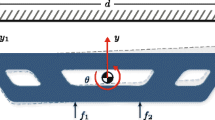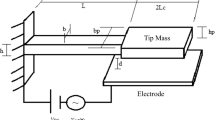Abstract
This paper addresses the optimal shape design of segmented spatial sensors and actuators that isolate selected mode shapes and perform modal filtering. Electromechanical filters have reappeared with the new manufacturing capabilities of micro-electro-mechanical structures (MEMS). In such small dimensions it proves essential to treat their elastic behaviour as continuous rather than discrete systems that require suitable design methods, some of which are developed here. In MEMS filters, the input signal is converted to external electrostatic forces and in order to perform the desired filtering, the electrodes need to be shaped such that they excite only a desired part of the dynamics. An optimization scheme that shapes these electrodes to achieve optimal filtering is developed. In order to enhance the filter’s performance and minimize energy lost to the supporting structure, a special support tuning method is proposed. Several simulated examples examine the effectiveness of the proposed optimization methods.
Similar content being viewed by others
References
Balmes E (2007) Structural dynamics toolbox for Matlab, User’s guide ver.6, http://www.sdtools.com
Bao MH (2000) Handbook of sensors and actuators. Micro mechanical transducers: pressure sensors, accelerometers and gyroscopes, vol 8. Elsevier
Bucher I, Braun S (1993) The structural modification inverse problem: an exact solution. Mech Syst Signal Process 7(3):217–238
Bucher I, Braun S (1997) Left-eigenvectors: extraction from measurements and physical interpretation. ASME transactions. J Appl Mech 64:97–105
Callahan J, Baruh H (1996) Active control of flexible structures by use of segmented piezoelectric elements. J Guid Control Dyn 19(4):808–815
Callahan J, Baruh H (1999) Modal sensing of circular cylindrical shells using segmented piezoelectric elements. Smart Mater Struct 8:125–135
Friswell MI (1999) Partial and segmented modal sensors for beam structures. J Vib Control 5:619–637
Friswell MI (2001) On the design of modal actuators and sensors. J Sound Vib 241(3):361–372
Gawronski W (1998) Dynamics and control of structures, A modal approach. Springer, New York
Gawronski W (2000) Modal actuators and sensors. J Sound Vib 229(4):1013–1022
Geradin M, Rixen D (1998) Mechanical vibrations—theory and application to structural dynamics, 2nd edn. Wiley
He J, Fu Z-F (2001) Modal analysis. Butterworth Heinemann
John D, Jerman H, Thomas W (2003) Design of large deflection electrostatic actuators. IEEE ASME J Microelectromech Syst 12(3):335–343
Kim J, Ryou J (2002) Optimal gain distribution for two-dimensional modal transducer and its implementation using multi-layered PVDF films. J Sound Vib 251(3):395–408
Kim SJ, Hwang JS, Mok J (2000) Sensor/actuator optimal design for active vibration control of shell structure. J Intell Mater Syst Struct 11
Mao Q (2004) Theoretical development and experimental validation of modal sensors. Acoust Sci Tech 25(1):81–84
Matlab (2007) Optimization toolbox for Matlab, User’s guide ver.2007b
Michael L, Mauro J (2001) Review of modal sensing and actuation techniques. Shock Vibr Dig 33(1):3–14
Nguyen C, Wang K, Wong A-C (2000) VHF free–free beam high-Q micromechanical resonators. J Micromech Syst 9(3):347–360
Preumont A (1997) Vibration control of active structures: an introduction. Kluwer Academic, Boston
Preumont A, Francois A, De Man P, Piefort V (2003) Spatial filters in structural control. J Sound Vib 265:61–79
Skelton R (1988) Dynamic systems control: linear system analysis and synthesis. Wiley, New York
Strang G (2006) Linear algebra and its applications, 4th edn. Brooks/Cole
Takagi K, Nagase K, Oshima K, Hayakawa Y (2001) Modal filtering for simply supported plate using equally segmented piezoelectric film. In: Proceedings of the American Control Conference Arlington
Tilmans H (1996) Equivalent circuit representation of electromechanical transducers, part I: lumped parameter system. J Micromech Microeng 6(2):157–176. doi:10.1088/0960-1317/6/1/036
Timoshenko S (1958) Strength of materials, part I: elementary theory and problems, 3rd edn. Melbourne
Zhang Q, Allemang RJ, Brown DL (1990) Modal filter: concept and applications. In: International Modal Analysis Conference, IMAC conference proceedings
Zhuang Y, Baras JS (1994) Shape optimization of distributed sensors and actuators for smart structure control. In: SPIE proceedings, Smart Structures and Materials
Author information
Authors and Affiliations
Corresponding author
Rights and permissions
About this article
Cite this article
Elka, A., Bucher, I. Optimal electrode shaping for precise modal electromechanical filtering. Struct Multidisc Optim 38, 627–641 (2009). https://doi.org/10.1007/s00158-008-0303-y
Received:
Revised:
Accepted:
Published:
Issue Date:
DOI: https://doi.org/10.1007/s00158-008-0303-y




